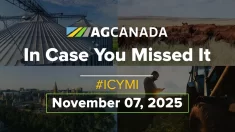MONTMARTRE, Sask. – As mayor of a small Saskatchewan town, Wayne Myren has led his town to the cover of newspapers for its economic development accomplishments.
Last year, Ogema won international awards from China for its development activities.
Most importantly, Myren and his neighbours have brought the town back from the brink, saving their school, increasing the town’s population by 60, building businesses and proving that rural communities are not only viable but also valuable.
“You need an attitude just like the pioneers had when they came here and started with nothing,” said Myren, the local Napa Auto Parts owner who has been Ogema’s mayor for the past nine years.
Read Also

Europe holds promise for Canadian lentils
Pulse Canada is trying to help boost lentil consumption in Europe, which is already the fourth largest market.
“You need an attitude that, ‘this is my home and I’m going to protect it and I’m going to leave it a better place for my children.’ ”
In the 1980s, Myren would have been leaving his children a town with a shrinking population that had dipped to 290, a school whose enrolment was down to 50 students and an economy that was faltering badly.
But in 1989, Myren and other Ogema residents decided it was time to save the town, no matter what it took.
Their efforts resulted in a group-owned section of railway, several agricultural related businesses along the railway, hog barns that employ 55 Ogema residents, an award-winning pioneer museum, a school population that has jumped from 56 to 90, a 25 spot day care in the town’s school and a population that has risen to more than 350.
As well, the town has been a model in southern Saskatchewan for its immigration strategy, attracting 14 immigrant families to the community.
“What you need is a core group of people who are willing to take control of their own destiny and everybody has to dig in and help as a group,” said Myren, referring to the 25 core community organizers who sit on Ogema’s councils, economic development committee and other local boards.
“These people, from farmers to businesspeople to wage earners, just work hard and they’re involved in almost everything. They believe in the town and they plan for its growth.”
Myren said rural towns that want to survive also need a solid strategic plan that includes business development, facility upkeep and ways to keep its young people involved.
Ogema revisits its plan regularly to make sure the community is on track.
“For example, one of our goals in that document is to establish a round-trip heritage train tour which will run on our 117 kilometre track.”
The town already has a train station in place, moving and refinishing it with volunteer labour.
“It’s a huge project, but we’ve got a soft start scheduled for 2010 and we want to be a heritage destination on the Prairies that shows people first-hand the experience of our pioneers. And because we have that goal, we know we’re going to get it done, just like we’ve gotten everything else done.”
Patsy Fisher, village councillor in Montmartre, Sask., agreed that community development is about attitude.
“What we did in Montmartre is start something called the Positive Post,” Fisher said about the community-sponsored publication that shares the town’s good news on a monthly basis.
“That newsletter really got people seeing the positive things in our town and because we send it to hundreds of former residents, suddenly they were coming back home and praising us for all of the good things that were happening. And sometimes, it just means more when you hear that feedback from outside of your town.”
In the last seven years, the village and rural municipality, with a population of nearly 1,000, have attracted 10 to 20 new residents a year.
As well, the community has turned into a bustling tourist destination complete with a 30-foot-tall Eiffel Tower, a full-service campground, pool and park, nine-hole golf course, a mini artisan mall and a boutique and bistro.
With a school population of 190 students, a health-care centre, a handful of new homes and a 40 space day care set to open in the school in the coming year, Fisher said the town is not only surviving but thriving.
“It’s not about any one big business or industry that came in and saved us, it’s about taking every idea that came our way seriously and developing every area of our town, from education to small businesses to tourism,” she said.
Several businesses have expanded and a farmers’ market that started in 2002 has helped spawn many new home-based ventures.
“What we’ve been able to do is stay open to new ideas, like when we decided to transform our town into the Paris of the Prairies this past year, and a few months later a former resident read our idea in the Positive Post and built and donated a $15,000 steel Eiffel Tower; that’s the kind of karma that comes your way when you stay open to new ideas.”
This year, Montmartre also earned the Saskatchewan Municipal Award in the community development leadership category for its Centre 48 project.
The arts and education centre was established seven years ago and was the first project developed under the community’s economic development committee.
“Again, Centre 48 isn’t an ethanol plant or a hog barn, but what it does is keep people in the community, it keeps the school active and, overall, it creates a vibrant town that has learning opportunities for all age groups,” said Fisher, referring to classes such as music, yoga, belly dance, circuit training, painting, quilting and play school.
Myren said every prairie town has the potential to flourish, but people with positive energy need to rally hard against the forces of rural depopulation.
“What it comes down to is towns have to get rid of their CAVE men, that’s Citizens Against Virtually Everything, and you have replace that with positive energy,” he said.
“You see those towns where the community’s people don’t grasp that and they fight amongst themselves or wait for what the government is going to give them, but the bottom line is no one else is going to save your town but you.”
Fisher said once the town’s leaders start to think positively, the attitude spreads and all people in the community start to feel empowered.
“My mantra is never be afraid to dream out loud,” she said.
“We’ve had so many things develop in this town because of people who weren’t afraid to say, ‘I have this crazy idea.’ ”
She said several developments have come directly from citizens, such as Montmartre’s first folk festival scheduled for 2010 that is being initiated by a family of nine who returned to the town after seeing so many positive developments.
Another project, a large igloo carved by hand by an 80-year-old resident, has become the centre point for the community’s annual Fire and Ice Festival in January.
“Every town has people with these ideas, and all you have to do is encourage that creativity and be open to anything that will bring interest, people and business to your town.”














